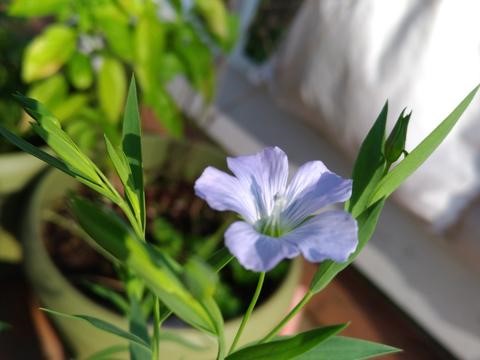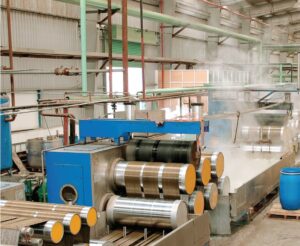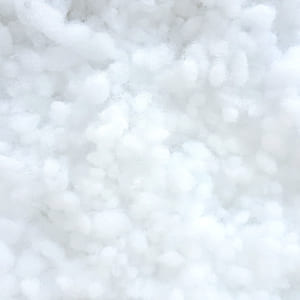What is linen?
Linen has long been the fabric of choice for staying stylish in the heat. Its naturally hollow fibers make it highly water-absorbent and breathable. Its natural crispness gently drapes the fabric to hang away from the body, keeping the wearer cool and comfortable. 60% less water is required to grow flax compared to cotton and up to 2.1 tons of CO2 are absorded per ton of flax cellulose produced. Although it boasts healthy environmental credentials, linen remains a luxury fabric due to the painstaking care needed to prepare the fibers. These come from the blue-flowered flax plant, grown chiefly in cooler climates such as in Western Europe.
After harvesting flax needs to be ‘retted’ to separate the binding between the long fibers and the woody stem. Traditionally this is done with water, either by laying on a field to be retted by the dew or in a pond or stream. This can take from a few days to a few weeks. Chemical retting is faster, soaking the plants in a solution of alkali or oxalic acid, then pressurizing and boiling them.
To remove the woody parts, the plants are then ‘scutched’, crushed between rollers, or ‘hackled’, pulled through beds of nails, to remove the woody parts. The remaining soft fibers are spun and woven or knitted. Much of this process is still carried out by hand.
Linen is extremely strong, can be washed or dry-cleaned, and has a natural sheen and stiffness that softens with wear. Its tendency to crease easily can be partly overcome by blending with other fibers. Linen is long-lasting, absorbs dyes and prints well, and does not pill.
Linen is a natural fiber that stems from the flax plant. It uses considerably fewer resources than cotton or polyester (such as water, energy, pesticides, insecticides, fertilizers).
Flax can grow in poor soil which is not used for food production. In some cases, it can even rehabilitate polluted soil. Flax plants also have a high rate of carbon absorption. For these reasons, we consider linen to be a sustainable material, even when it is not organically grown.
Pros:
- Mechanically processed by scutching: you just break the stem and manually extract the fiber.
- Can grow in Canada (in fact, Canada is the largest flax seed producer in the world).
- Very strong fiber. Clothes last longer.
- Flax seeds are beneficial for health.
- Provides raw material that can be used by several industries.
- Biodegradable
Cons:
- The expertise for processing, spinning, and knitting flax remains to be developed in Canada and the USA (if you are in France or Belgium, that’s a pro for you).
- Linen fabric requires higher maintenance (wrinkles easily).
- The fiber may need to be degummed using sodium hydroxide and sulfuric acid. I still need to find more info on that.
Tiny market share
One of the oldest fibers known to man, flax has been used to create cloth since at least 8,000 BC. For centuries linen was a major commodity in clothing and textiles, with Belfast the world-leader in Victorian times.
In recent decades linen has been eclipsed by both cotton and manmade/synthetic fibers. In 1961 more than 2 million hectares of land globally were cultivated with flax. By 2000 this had dropped to less than 450,000 hectares. France is the world’s largest producer of flax followed by Belgium, Belarus, and China.
Flax has a less than 1 percent share of the world fiber market. Most of the flax grown – 60 percent – is used for clothing; 15 percent for household linens and 15 percent for furniture or other lifestyle products. A by-product of flax grown for textiles is linseed oil1.
Environmentally positive
Flax thrives in temperate climates and is a resilient plant, requiring few fertilizers or pesticides – although it needs more tending than hemp which flax is often compared to. Usual rainfall is enough to irrigate European cultivations of flax, unlike cotton which can require high volumes of water depending on where it is grown. Flax can be grown organically – indeed many cultivations are already close to the organic standard.
The cultivation stage of producing linen is the least water and energy-intensive part of a linen garment’s lifecycle. According to a 2008 report for the European Confederation of Linen and Hemp (CELC), almost 80 percent of linen’s energy and water consumption derives from washing and ironing the garment2.
Across its lifecycle, a linen shirt uses 6.4 liters of water compared with 26 liters for a cotton shirt, according to the CELC report3. This is because of the intensive irrigation typically required in cotton-growing. (Although water consumption in cotton varies considerably depending on whether it is rain-fed or irrigated, cotton would compare marginally better).
Flax cultivation has other environmental benefits, the report argues. It also has an 18 percent less excessive build-up of algae compared with cotton; higher algae levels indicate excessive concentrations of phosphate or nitrate in water. Flax also presents a lower toxic risk for aquatic systems than cotton.
The Sustainable Apparel Coalition’s Higg Materials Sustainability Index seems to disagree about algae (eutrophication) indicators. It gives linen a score of 22.2 compared with 9.1 for cotton and 1.5 for polyester4.
Linen also has a slightly higher energy consumption [than cotton] due to the need to iron linen more5.
The Made-By Environmental Benchmark for Fibres, which assesses the impact up to the production of yarn or fabric but not the full lifecycle of a material, ranks conventional flax as Class C and organic flax as Class A.
The Global Organic Textile Standard (GOTS) also applies to linen. As with all GOTS certification, it covers the processing of the fiber into linen, not the cultivation of flax which is covered by governmental organic standards.
Pitching linen’s green credentials
The CELC is keen to raise the profile of European flax and linen by highlighting environmentally friendly attributes. According to the CELC…
- Every year, flax-growing in Europe captures 250,000 tonnes of CO2 – saving emissions equivalent to driving a Renault Clio around the world 62,000 times.
- Buying a linen shirt instead of cotton will save thirteen 1.5 liter bottles of water.
- If all French people tomorrow bought a linen shirt instead of a cotton one, it would save the equivalent of all Paris’s drinking water for a year.
Source: https://respecterre.com/blogs/news/the-best-eco-friendly-fibres
Source from Commonobjective. co





